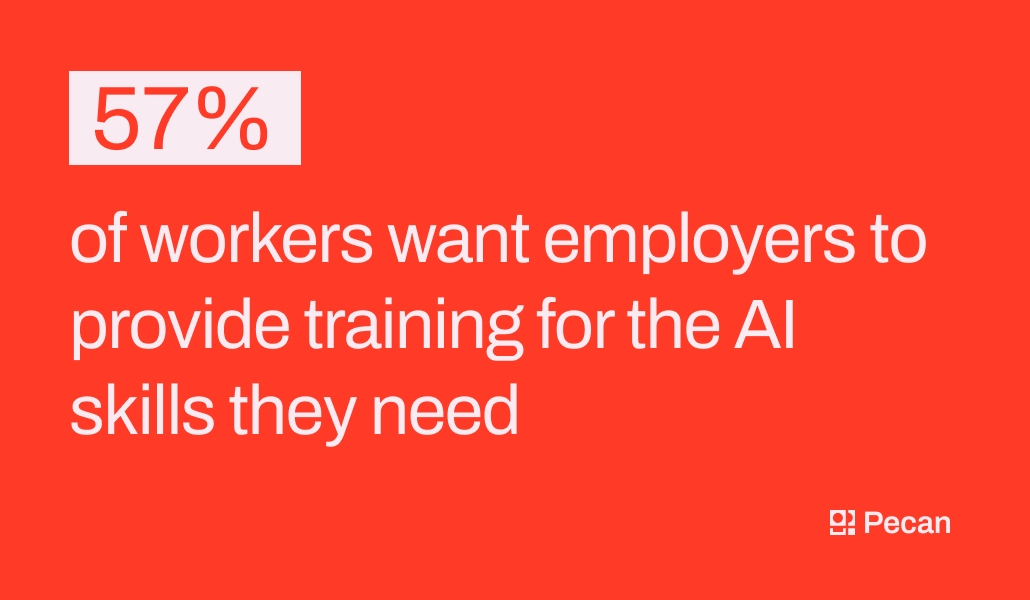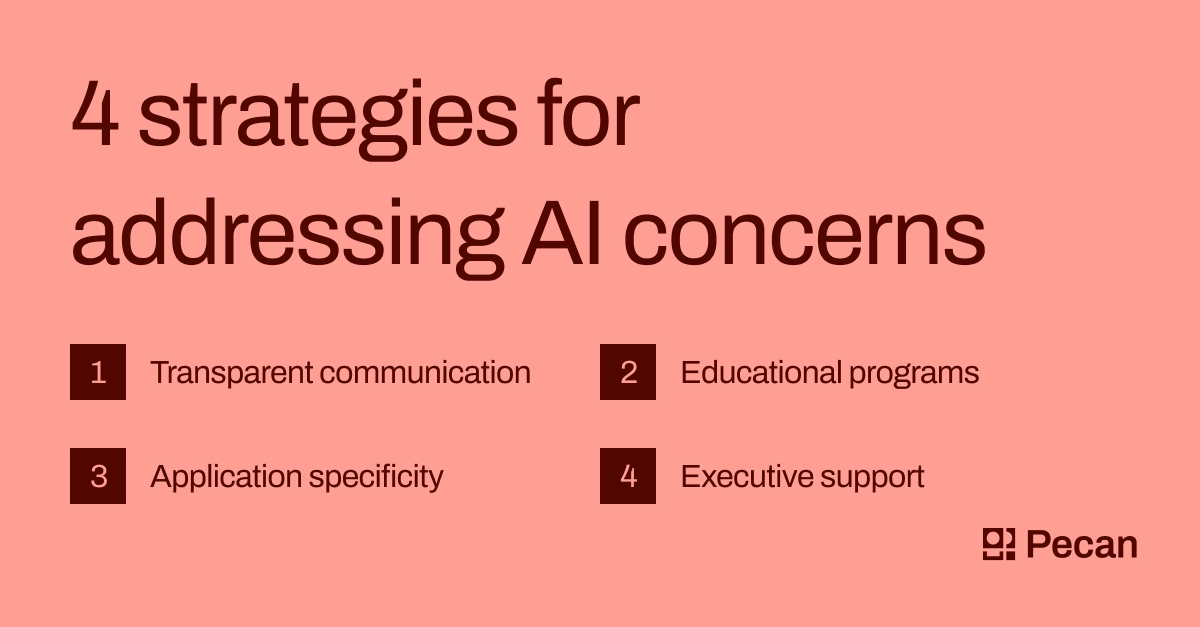In a nutshell:
- Organizations are facing various concerns and hesitations when it comes to integrating AI into their workflows.
- Common concerns include job loss, security and privacy issues, inadequate training, and ethical concerns.
- Strategies for addressing AI concerns include transparent communication, educational programs, application specificity, and executive support.
- Pecan is a low-code Predictive GenAI platform that can help organizations overcome AI hesitation and empower AI integration.
Chances are high that you’re in one of the many organizations that have begun integrating artificial intelligence into your workflows.
Whether you're deep into AI workstreams or just getting started, your organization has likely been running into a few obstacles. Your leaders or employees may have concerns, and if that’s the case, they’re not alone.
Feelings on AI are a mixed bag. One Pew Research Center study demonstrated that only 15% of respondents were excited rather than concerned about increased AI in their daily lives. Another report from the World Economic Forum showed that two-thirds of respondents said that they think AI skills will improve their career options and make them more employable. Clearly, there are varied sentiments.
Amidst the swirl of skepticism and excitement, it’s of the utmost importance to understand the causes of hesitation related to artificial intelligence adoption — and to develop a proactive strategy for combating them.
Concerns about AI
From job loss to privacy, there’s a long list of potential concerns about AI floating around your office. Let’s take a closer look at the most common hesitations people have when it comes to integration — and what the data has to say.
Job loss
The most prominent issue causing AI concern in the workforce is job loss. This sentiment has been buzzing on online forums and social media sites for months. 24% of the workforce is nervous about having their job taken over by artificial intelligence.
Job displacements are increasing in connection with AI integration. ResumeBuilder spoke with 750 companies taking advantage of AI in 2023. That year, 37% of the organizations highlighted that AI technology replaced some of their workforce.
-

- AI will lead to changing jobs — and many new jobs
By 2025, it’s calculated that AI may have taken over 85 million jobs. But, interestingly enough, AI’s job creation numbers are redeeming: 97 million new jobs are expected to be created by integrating AI into the workforce. So, the issue of job loss isn’t clear-cut.
Our hypothesis is that AI will replace some entry-level workers but also create new jobs and enhance the majority of workers’ jobs, helping them do more with less via automation and data insights.
Security and privacy concerns
With increasing nationwide and global regulations and mainstream concerns about data privacy and security, some AI resistors are hesitant about data safety. 65% of organizations highlight that data privacy and cyber issues are one of the leading causes of concerns for using artificial intelligence within their company.
While understandable, these concerns aren’t reflected in the data. Organizations prioritize compliance for good reason, but AI actually performs better in security than its human counterparts.
IBM Security discovered that accuracy rises by 30% when AI is used to detect anomalies instead of other methods, and Security Magazine noted that AI can enhance threat detection (but not without human monitoring).
While it’s easier to trust what’s always been done when it comes to data processing and security, it’s important to counter our distrust toward AI with data. The facts argue that AI may be the next big thing in cybersecurity.
Inadequate training and low AI literacy
Another reason employees may feel hesitant to incorporate AI into their workflows is low AI literacy or inadequate AI training. According to Gallup, only 53% of workers feel ready to incorporate AI into their workday. That means most of the workforce isn’t feeling adequately prepared.
-

- Workers hope their employers will help them transition into the age of AI-supported work
While the majority of workers don’t feel ready to work with AI, 57% of workers want their company to provide the training needed to get the AI skills they need. That means a disconnect is happening — many people feel like AI will help them in their jobs, but they aren’t equipped to navigate it yet. Providing training will likely be a differentiator for organizations moving forward.
Ethical concerns
Significant ethical discourse has taken place regarding AI and its workplace integration. Ethical concerns span a few categories, including:
- Misinformation: Artificial intelligence uses available internet information to reach conclusions and produce outputs. Generative AI programs may pull information that is not factual or create false facts called hallucinations when there isn’t available information.
- Copyright concerns: Because AI takes advantage of existing resources, there are significant concerns about repurposed material violating copyright laws. Additionally, published material may be highly plagiarized if not edited.
- Bias: If an AI bot is trained on non-representative data, it can communicate or exacerbate bias within its outputs.
- Deepfakes: Generative AI tools don’t just extend to written content — they can create realistic images and videos that can negatively affect the subject and the viewers of the content.
Because AI’s dissemination into the workplace is relatively new, many ethical issues haven’t yet been fully resolved. For example, there are dozens of lawsuits relating to potential copyright issues pending in the United States. All of these concerns may be impacting your company’s AI initiatives, and you’ll likely need to address at least some of them.
Strategies for addressing AI concerns
Take some time to gauge your team's hesitations about AI so that you can address them accurately and efficiently. Once you know the major problems, you can apply one or more of the following strategies to improve your AI approach as an organization.
-

- Ways to achieve support for AI in the workplace
Transparent communication
Developing a culture of transparent communication related to AI adoption is a vital first step in helping your organization feel empowered to integrate the technology. People need to feel comfortable asking questions and expressing concerns. When you build a space for transparent communication, you proactively address fear and concerns before they negatively impact your culture.
A few ways to develop transparent communication are:
- Providing specific points of contact for AI questions and concerns. When team members know who to approach with issues or concerns, they’re more likely to bring them up and find a resolution.
- Incorporate group discussion throughout the integration. When one team member has a question, the chances are high that others have the same question. Increase opportunities for communication and learning through group collaboration and discussion, such as town halls or company- and team-wide meetings.
- Initiate dialogue. Rather than expecting team members to express their concerns and hesitations, have your organization’s contact points initiate dialogue through regular check-ins.
Educational programs
Another major hurdle related to AI integration is education. Many employees aren’t sure how to use AI tools or find applications for them. They also might be more likely to cling to negative perceptions of the tools because they lack a high level of understanding.
To tackle these problems, consider integrating both internal and external training.
Internal training relates to AI instruction that’s typically provided by a manager or an L&D team. If you have an AI expert on staff or your software engineers are developing a custom tool, it may make sense to deliver internal training on specific applications and AI principles.
If you want to encourage a broader understanding of AI and its capabilities, bringing in external training might be a good call. Loads of AI courses exist from online sources like Udemy and Coursera. These can get your employees up to date on general practices.
Your company's tools likely provide some training materials. Allow your employees time to navigate tutorials, guides, and free trials as you begin implementing new AI technologies. Consider using a low-code analytics platform like Pecan to shorten users' learning curve.
Application specificity
Artificial intelligence offers seemingly endless opportunities for application — which can lead to overwhelm for hesitant AI users. When you’re first getting started with AI at your organization, clearly define areas of application so your team members can gain confidence.
When you teach team members how to execute specific, narrow tasks, you can build trust in AI as a valuable technology. You also build some of the skills necessary to navigate these tools.
Once your team understands the basics of AI, employees can start getting more creative with applications. But when you’re first starting out, consider putting parameters on what types of projects they can use AI for or and which tools they can use.
Also, consider integrating an approval pipeline for AI applications. Team members who are comfortable brainstorming applications and researching tools can have a point of contact for approval, which helps keep your organization invested, organized, ethical, and secure.
Executive support
One final step for ensuring organizational success with AI is garnering executive support. While departmental acceptance of AI is essential, leadership acceptance is a must. For the best results, AI initiatives need to be supported across the company—vertically and horizontally.
One of the major benefits of executive support is a culture of exploration. Leadership Success states that empowerment, intelligent risk-taking, and open communication are a few of the things that make for explorative cultures. When executives support AI initiatives, they’re planting the seeds for a positive and creative culture.
To actively engage executives, consider organizing regular AI strategy meetings where leaders can review progress, provide feedback, and align AI objectives with broader company goals. You can also create a channel for executives to share their success stories and challenges with AI, fostering a supportive and informed leadership network.
How Pecan empowers AI integration
Pecan is a low-code Predictive GenAI platform that makes an excellent first tool for organizations looking to capture the value of AI. The platform features a forgiving learning curve with unlimited potential.
To build predictive models in Pecan, users simply need to engage in a conversation with a generative AI chatbot. This bot navigates the user through the construction of a predictive model prompt by helping them specify a business-focused "predictive question" and then generating SQL for a relevant model. Then, Pecan builds the model—no coding necessary. Because Pecan is a platform, it also helps with other valuable steps of the data lifecycle, like cleaning and preparing data.
If you can have a conversation, you can take advantage of predictive AI with Pecan. Our tool is also highly secure, quelling fears of any data issues. Read more about Pecan’s security measures.
AI doesn’t have to be intimidating. If you’re looking for somewhere to start with AI change management, consider teaming up with Pecan AI.
It’s time to officially start your AI journey. Reach out to schedule a demo today.




